- Home
- Natural Remedies
10 Natural Hair Loss Remedies
By Paul Taylor
Some natural hair loss remedies might be worth trying, but you need to know which ones are safe and won't cause more harm than good.
This review will help. Just scan the list below and use the links to jump down the page and explore the various ideas presented. Or just read the summary at the very end of this article.
#1. Scalp Massage
#2. and #3. Magnets and Massage Devices
#4. Garlic and Onion (Without the Smell!)
#5. Best Essential Oils for Hair Loss?
#6. Natural Remedies for Hair Loss Growing in Your Garden
#7. Dermaroller Without the Needles
#10. Hair Loss Remedies Sitting in Your Garage?
#1. Scalp Massage
Over the years, various types of scalp massage have become traditional folk remedies for hair loss.
And it does make sense that something which can increase scalp circulation should also improve hair growth. So that's why, when many people start thinking about trying natural hair loss remedies, some form of scalp massage immediately springs to mind.
Scalp tension and inadequate scalp circulation to the hair follicles play a big part in the hair loss process. But a very simple way to tackle this is to use the "pinch massage".
From the diagram below, you can see that there are two ways of doing this: laterally and longitudinally.
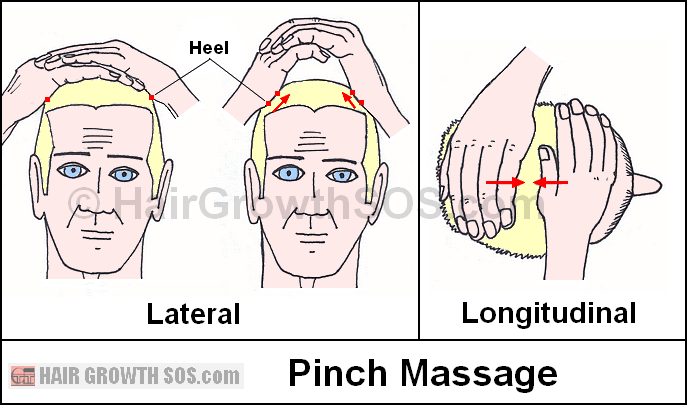
Laterally
Cup both hands and put four fingers of one hand on top of the corresponding four fingers of the other hand as shown. Another way to form this is to simply make a "cradle" shape with your hands which then fits snugly over your scalp.
Then, simply use the heels of both hands to squeeze inwards and upwards on the sides of your head towards the center of your scalp as indicated by the arrows. You’ll feel the scalp flex upwards.
Repeat this "pinching" action several times in four or five positions between the front and back of the scalp. As a visual aid, just think of your hands as a clam shell trying to open and close.
Longitudinally
Lay both hands flat on the top of your scalp as shown. Notice that there’s a small gap (maybe two fingers wide) between each hand.
Press both hands slightly downwards and push (or pinch) them together in the direction of the red arrows. Then pull both hands apart again. Repeat this "open and close" action several times in several positions between the front and back of the scalp.
How often should you feel the pinch?
You can use the pinch massage as often as you like (or whenever you get the chance) during the day. I especially suggest you apply both methods as and when you get that "stressed out" feeling where your scalp feels tight and maybe itchy too.
The pinch massage is a very quick, easy way to help increase scalp flexibility and improve scalp circulation. I introduced it to readers in an ebook I wrote called "Hair Tomorrow Too" * which I made available from this website back in 2012.
* The idea behind "Hair Tomorrow Too" was to give further help to those who wanted to do everything possible to tackle their hair loss. However, my main techniques for stimulating hair regrowth are contained in my first ebook: "Here Today, Hair Tomorrow".
#2. and #3. Magnets and Massage devices
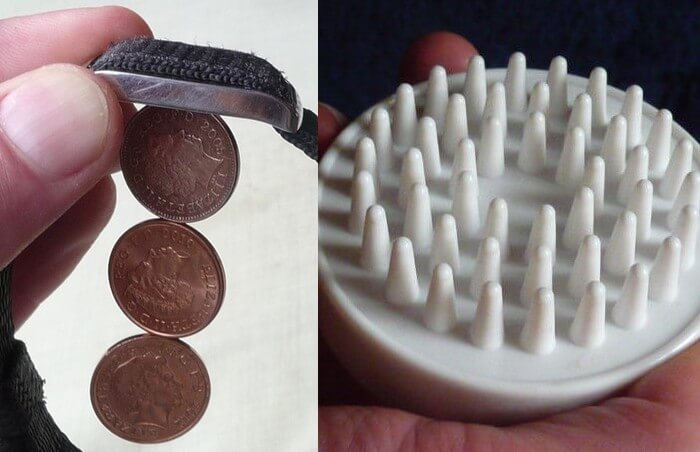
There are many different types of massage device you can buy. Most are relatively cheap, so cost might not really be a factor. But, other variables to consider include:
- Manually or electrically operated?
- Material (wood, rubber, plastic, etc)?
- Does it work alongside something else (essential oils, heat, magnets*, etc)?
* Magnet therapy can also increase scalp circulation to some extent, albeit in a different way. Magnet therapy does it through ionization by magnetic induction (IMI), whereas scalp massage obviously uses physical manipulation.
But are magnets or scalp massage products really that effective as hair loss remedies? And what combined effect might they have when used together?
Read the scalp massager and magnet therapy review to find out.
#4. Garlic and Onion (Without the Smell!)

Several hair loss remedies involve rubbing various naturally-occurring substances onto your head.
The idea, of course, is that they'll deliver active ingredients directly to the affected region of the scalp whilst at the same time:
- Save money from expensive topical hair loss products.
- Avoid unwanted extra ingredients which might cause undesirable side effects (e.g., topical hair loss products often have an alcohol base which can over-dry the scalp).
- Avoid the unpleasant smell from the chemical cocktail hair loss products often contain.
So that's three very good reasons why many people prefer to use natural substances instead.
Garlic and onion are used by some people as potential hair loss remedies largely due to the sulfur they contain.
However, their high sulfur content also makes them very pungent - something that's extremely off-putting for a lot of people, maybe even more so than the chemical smell from hair loss products!
So if the thought of rubbing garlic or onion onto your head makes you want to cry, read the article below to get some alternative ideas for using garlic and sulfur to help grow your hair.
How to use garlic for hair growth.
#5. Best Essential Oils for Hair Loss?
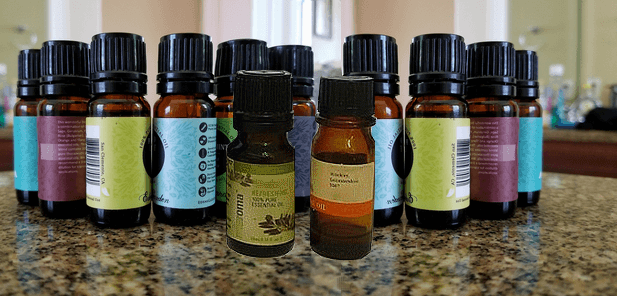
The main idea behind using essential oils (aromatherapy) as a safe, natural hair loss remedy is to put concentrated botanical extracts into your body.
This is normally done using a "carrier" oil such as almond oil or olive oil.
However, emu oil is sometimes said to be the oil absorbed best by the body. So, if you use emu oil instead, it might deliver more of the essential oils down into your hair follicles and give yourself the best chance of dealing with the root cause of your hair loss problem.
Essential oils have been used for hundreds of years, so it's not really surprising that the number used as hair loss remedies form a very long list.
And that also means the potential number of essential oil combinations you could blend together is mind-boggling!
So that's why my essential oils for hair loss review compares 5 scientific studies and brings together the top suggestions.
#6. Natural Hair Loss Remedies Growing in Your Garden
It should be quite easy to grow some very well known herbs used for hair loss in your own backyard.
Basil, lavender and rosemary quite often find their way into the ingredient lists of hair loss remedies. That's because they can improve scalp circulation, something which will clearly be of benefit to hair growth.
However, the benefits of growing your own herbs also extend beyond using them as hair loss treatments:
- As your herbs grow, they'll exude a pleasant aroma across your land.
- You'll be eating fresh, organic herbs that are really healthy for you.
- Save money. Herbs can be expensive!
How to make your own herbal hair loss treatments
Creating your own hair loss treatments using herbs is quite simple.
You basically just need to take either fresh or dried* herbs and apply them directly to the hair loss region of the scalp in some topical form - either crush them or mix them with a liquid ingredient to help absorption (e.g., emu oil or your regular shampoo).
* Unless you can continuously grow and use fresh herbs all year round, it makes sense to dry some of the herbs you harvest, and then store them indoors for later use.
Exotic herbs
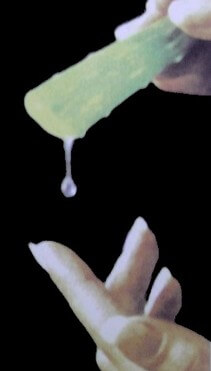
Some of the more exotic species of herbs used as hair loss remedies might not be quite so simple to grow yourself.
These include some herbs well known in traditional Chinese medicine.
However, one exception is aloe vera, a herb widely used in many hair loss treatments and products. Aloe vera is a desert dweller, so it should be easy enough to grow indoors using plant pots or a conservatory (or even outdoors if you have a greenhouse or live somewhere hot and dry).
It's quite well known that cutting an aloe vera leaf and applying the inner gel/sap onto burns and wounds can help accelerate the healing process.
So, by rubbing it into the hair loss region of the scalp, it might just be able to stimulate hair growth the same way. Remember though, as with all naturally-occurring hair loss remedies, you'll probably need to persevere for several months - you can't expect results overnight!
Here's a list of 8 hair loss herbs, many of which you should be able to grow at home:
- Aloe vera
- Basil
- Green tea
- He shou wu (fo ti)
- Lavender
- Nettle
- Rosemary
- Saw palmetto
Read this article to learn more about these herbs, how to use them, and which ones are most likely to work.
#7. Dermaroller Without the Needles

A dermaroller is a very simple product which aims to stimulate hair regrowth by rolling hundreds of tiny needles over your scalp on a regular basis.
This process (called microneedling) causes micro skin trauma which then activates the skin repair and hair growth mechanisms.
Also, by perforating the skin, any topical products you're using will get better absorbed, making them more effective.
Whilst all that might sound hard to believe, scientific studies have proved that dermarollers really can help both skin repair (1) and hair regrowth (2). However, using a dermaroller is not without its issues, including:
- Hygiene - Obviously if you're sticking hundreds of needles into your head, you need to be careful! You must keep a dermaroller meticulously clean.
- Needle length - A dermaroller with longer needles will penetrate deeper and carry a greater risk of infection or excessive skin trauma.
- The needles can get snagged in your hair and pull it out*.
* Using a dermastamp instead will avoid the rolling action and so, should prevent this problem.
Since needles and injections immediately make you think of medical procedures, you might think that dermarollers and microneedling are anything but natural.
However, bear in mind that the skin repair and hair growth mechanisms they induce, certainly are natural.
Even so, some people simply don't like needles. If that's you, then I may have a solution:
There are many other very simple potential remedies for hair loss you could try which might work in a similar way.
Most people already have plenty of "pointy things" lying around which could easily double up as a makeshift dermaroller providing they're not too sharp. A very obvious example is shown below:
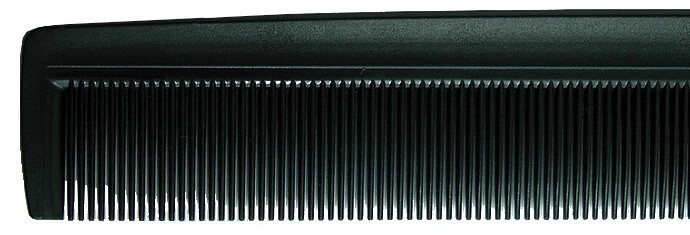
So, whilst a dermaroller might risk snagging your hair and pulling out more than you're trying to grow, simply pressing a comb into your scalp definitely won't.
And, since everyone already has a comb, if this idea really does help, then you've basically got yourself a completely free way to tackle your hair loss.
Note: A comb probably won't increase absorption of any hair loss product, but it will increase scalp circulation for a while. Also, you have to be careful - if you press too hard and for too long you might make the skin raw and could even cause bleeding.
Learn more about dermaroller and dermastamp products for hair loss.
#8. Gravity exercises
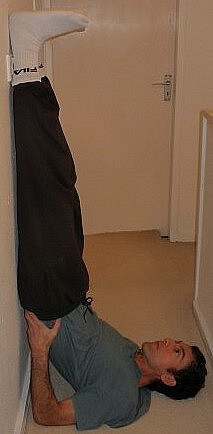
Some remedies involve the use of gravity. The idea is, of course, to invert (or partially invert) so that gravity will assist the flow of blood to your scalp.
This is, perhaps, a slightly strange idea. But hanging upside
down might be an obvious thought people have once they learn that decreased scalp circulation plays a large part in the hair loss process.
There are several postures or exercises that employ gravity.
Shoulder stands (either with or without a wall to prop yourself up) are probably the fastest way to increase scalp circulation.
Other, less extreme versions that don't require the same degree of strength, flexibility and balance include simply lying on your back and lifting your legs up against a wall.
It's easy to understand why people might try gravity exercises like these as a possible remedy for hair loss. Clearly, they're very easy to perform (if you're relatively young, fit and healthy) and completely free.
You can also buy special chairs or tables which are pivoted so you can easily swivel into an inverted position. And this ease of use could tempt someone into spending a lot more time inverted too.
But whilst such products might at first appear safe, especially for someone who might not be young or fit enough to get into an inverted position on their own, there's a big potential problem with any gravity-related idea:
Inverting on a regular basis to try and save your hair is not suitable for someone with certain medical conditions such as glaucoma (increased pressure in the eyes) and hypertension (high blood pressure).
Indeed, studies have shown that completely inverting, or using certain head-down yoga postures, might increase the risk of glaucoma progression (3) and can significantly increase blood pressure (4). Note though that results from other research suggests that hatha yoga postures do not significant effect blood pressure (5).
There's no doubt that, on the face of it, using gravity appears to be an all-natural way to help regrow your hair. But spending a prolonged amount of time in an extreme position (i.e., fully inverting your whole body) is certainly not a very natural or sensible thing to do.
Bottom line: we're humans, not bats!
#9. Aerobic Exercises
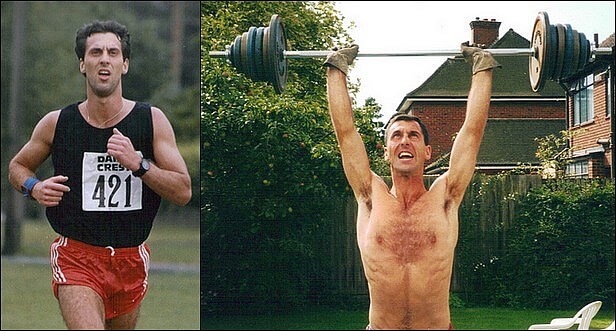
It might sound a bit hard to believe, but certain physical exercises might also contribute as a remedy for hair loss.
Here are four very good reasons why aerobic exercises (cycling, swimming, jogging, walking, etc.) might just be able to help with hair loss:
1. Decrease in stress levels - Hair loss can sometimes be stress-related. So, since exercise is fun (right?) it should help relieve any type of stress you suffer which might be making your hair loss worse.
Of course, you have to get the balance right. Very strenuous* physical exercise might actually increase rather than decrease your stress levels.
* See point 4 below.
Clearly then, moderation and enjoyment are the keys to success. Exactly how much success you get obviously depends upon how large a role stress plays in the hair loss you have.
2. Increasing blood supply to the hair follicles - Aerobic exercise will increase your breathing rate, heart rate and blood pressure. All of which means more oxygen getting absorbed by your lungs, more blood pumping around your body, and improved circulation.
And that also means more nutrients will get delivered to your scalp - something which can only help with hair growth.
3. Burning calories - If you burn off excess calories, that should mean fewer get converted into saturated fat. And since testosterone is manufactured from fat and cholesterol, that will also mean a decrease in testosterone and dihydrotestosterone (DHT) production as well.
4. Lower testosterone and DHT levels - Researchers have shown that regular endurance training (i.e., strenuous aerobic exercise) performed long-term (i.e., years) can reduce testosterone levels (6). And this, in turn, might mean less DHT and less hair loss too.
Note: heavy weight lifting (anaerobic) exercise will increase testosterone and DHT levels, and this is why heavy weight training for bodybuilding has been linked to hair loss. Basically, DHT encourages both muscle and bone growth. And this bone growth also includes certain bones of the skull in those men and women with the genetic link to hair loss.
Learn how skull bone growth causes hair loss.
Personally, I think the best way of looking at aerobic exercise is that, by simply running around or riding a bike, you might be helping some of the other ideas you're using.
And speaking of bikes:
#10. Hair Loss Remedies Sitting In Your Garage?
It might sound bonkers, but red light can stimulate faster hair growth. And that's the reason why laser hair loss therapy has had some success.
However, there's been some debate as to whether or not laser light gets scattered as it hits the skin and enters the body.
Evidence suggests that it does scatter. In which case, you might do just as well using some other cheaper and safer form of red light instead.
So if you've got a few items that use red light, then you might already have your own version of hair loss light therapy just lying around waiting to regrow your hair. For example, a bicycle sitting in your garage.
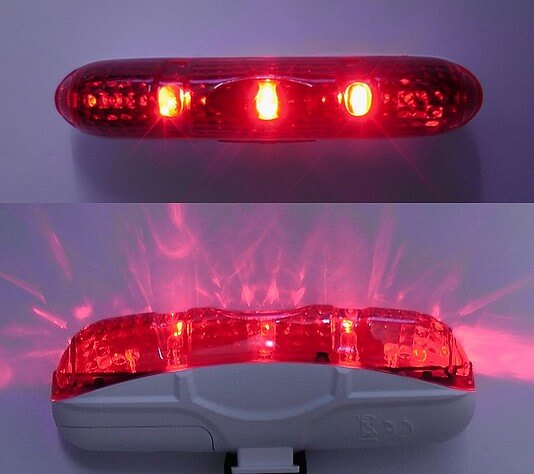
Rear bike lights typically use red LEDs. And most of them have constant beam and flash settings too, which is good because some research suggests that pulsed light gives better results than continuous light.
Now you might think that shining bright red lights onto your head (be they lasers or LEDs) doesn't sound like a very natural thing to do.
But there's no doubt that bathing ourselves in at least some sunlight every day is natural and healthy. So really it's just a question of whether extra exposure to the red end of the spectrum is beneficial or not. The fact that red light can speed up hair growth strongly suggests it is.
However, lasers obviously don't occur in nature. So that's something which might lean you away from lasers and towards LEDs. Then again, intense red light in any form doesn't occur naturally either.
There's also a real complexity to light therapy, and a balancing act you need to get right - something which can be difficult, as indicated by some very mixed results and reviews.
So, perhaps it's not really surprising that the idea of using laser therapy for hair loss has raised many doubts for a lot of people.
Personally, from the research I've done, I don't see why there should be any real difference between using laser light or any other red light source.
So I'd say that, if you're interested in using red light to tackle your hair loss, trying something that's a lot less expensive than laser therapy and much safer too, is probably a better idea.
Make sure you do thorough research first though. Like I said, using red light for hair loss is complicated. Some of the things you need to research include: coherence, divergence, fluence, power level and wavelength.
However, if all that sounds a bit daunting, the good news is that you can quickly learn about all these things simply by reading my laser hair loss treatment review and HairMax LaserComb review.
You
should quite easily be able to get hold of bike lights or LEDs with
technical specifications that approximate to those used in laser hair
loss therapy (wavelength 650 nanometers, power level 5 milliwatts, etc).
Summary
Here's a very quick summary of the main points in this review:
- If you're going to apply substances to your scalp, essential oils are clearly a much better idea than garlic or onion! And herbs probably won't be as strong and, therefore, as effective as essential oils.
- Whatever topical choice you make, you might as well massage your scalp at the same time as you apply them.
- A dermaroller (or dermastamp) might mean two minutes of pain once a week. For some, it will probably seem worth it as long as it helps grow new hair. For others, puncturing their scalp thousands of times with sharp needles will, understandably, not appeal!
- Using magnets and shining red light onto your head might help a bit, but the extent to which they'll benefit you is questionable at best.
- Gravity exercises are definitely a no-no for some people. And even for the young, fit and healthy, there still might be a health risk involved.
- Everyone should do aerobic exercises regardless of whether or not they suffer hair loss.
With something as stubborn as hair loss, a multiple approach is definitely worth considering. And that's especially true if you opt for alternative remedies whereby any benefits they have might be minimal or need a long time to take effect.
So, good luck if you decide to try any of these, or your own, ideas. And by all means use the Commenting section below to let me know how you get on.
Note: before trying any of the hair loss remedy ideas on this page, you should first consult with a doctor to find out which type of hair loss you have and which ideas might be most appropriate for you.
Last updated: January 24, 2020
|
Like this page? |
|

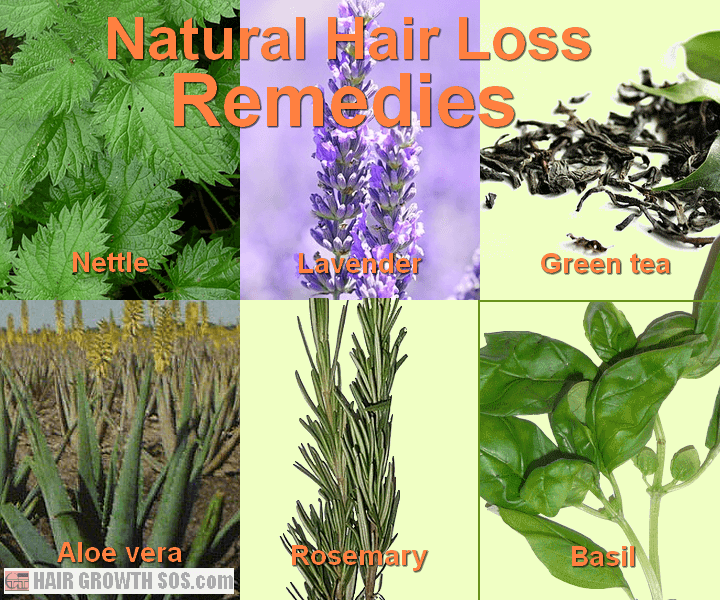

Comments and Questions?
Comments and questions about the page you just read are welcome. Just post in the box below. Please also observe the Commenting Rules (opens in a new window).